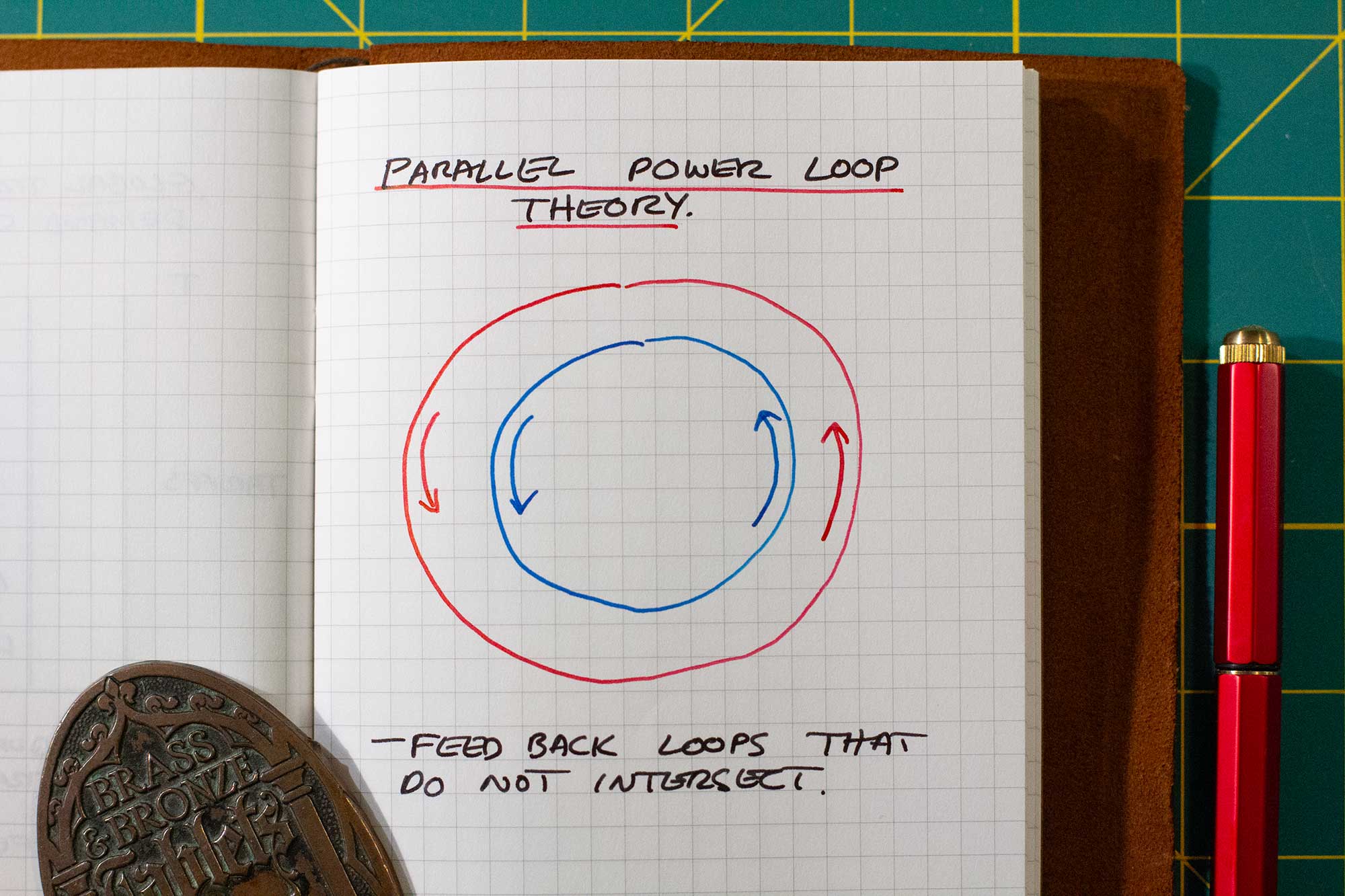Parallel Power Loop Theory
Parallel Power Loop Theory argues that competing systems of power operate and grow through self-sustaining feedback loops. Each loop contains stories, norms, and validations that continually reinforce the system’s internal logic.

Why Competing Political Power Systems Drain Each Other and the World They Share
Introduction
Parallel Power Loop Theory argues that competing systems of power operate and grow through self-sustaining feedback loops. Each loop contains stories, norms, and validations that continually reinforce the system’s internal logic.
While people may argue as if defending a shared reality, they’re often upholding entirely different rule sets. As one power loop gains strength, it drains energy from others, creating tension and disorientation across the landscape. This siphoning doesn’t just weaken the traditional consensus, it also destabilizes emerging visions of power, making it harder for any one system to fully take hold.
Table of Contents
- Part 1: Why the Rules No Longer Feel Real
- Part 2: Three Feedback Loops of Modern Power
- Part 3: When Power Systems Collide
- Part 4: What Comes Next
Author's Note
The framework introduced in this article is an original tool designed for making sense of the structural and emotional dissonance many feel today. I developed Parallel Power Loop Theory to describe a pattern I began noticing beneath the surface of our cultural and political debates: that power systems don’t just disagree—they run on entirely separate feedback loops. This article is my attempt to map those loops.
Understanding a system doesn’t mean agreeing with it. But it does help us respond more wisely.
Part 1: Why the Rules No Longer Feel Real
Understanding The Emotional Dissonance of Modern Power
When different systems of power collide, dissonance follows.
Many people were raised within a moral framework where power is earned. They were taught to work hard, follow rules, treat others fairly, and trust that doing so would bring rewards: stability, security, and progress.
Some, however, were raised in this same system and had a totally different experience. Power was withheld, opportunity was conditional, representation was scarce, and rules were unevenly applied. For these individuals, the traditional power system never delivered the promises that others took for granted.
But what happens when someone breaks every rule (or lives outside a rules-based system) and succeeds anyway?
The confusion this creates isn’t just political or emotional. It’s structural. Because what we witness isn’t simply norm-breaking behaviour, it's someone operating inside a different power loop.
A Closer Look at Parallel Power Loop Theory
Some frameworks that call for replacing "the system" focus on building new institutions, policies, or rule sets. Sometimes they call for a reset. Parallel Power Loop Theory offers a different lens—it defines systems not by rules or ethics, but by power: who holds it, how it's gained, and how it is rewarded. A power system can operate through institutions, but it is not limited to them. This distinction helps explain why some leaders thrive outside traditional structures, and why new systems of influence can rise even when formal institutions remain intact.
Parallel Power Loop Theory focuses on what each system offers its members. It asks and reveals:
- Who holds power?
- How does power grow?
- How is that power legitimized?
- What behaviours are rewarded in pursuit of power?
- What costs are tolerated in this system?
A power loop isn’t just a set of rules—it’s a framework for survival, success, and identity. Some power systems reward loyalty and tradition. Others reward disruption and dominance. Some are moral. Others are transactional.
The key insight is this: multiple power systems can coexist, and when they do, they often operate with completely different expectations. What seems irrational, unethical, or self-defeating in one power system may seem perfectly rational, ethical, and empowering in another.
These systems don’t just emerge once and remain static—they sustain themselves over time through internal feedback loops. Each generation inherits not just values or traditions, but a pattern of action and reward that keeps the loop spinning. And as one loop gathers momentum, it often does so by drawing energy away from other systems trying to do the same.
We tend to assume there’s one shared reality. That the people operating in one power system are “breaking the rules” when they don’t conform to our norms. We rarely consider that they may live by a completely different set of rules. Beneath the surface, there are parallel and often conflicting power loops in motion, and their lack of overlap is what creates the dissonance many are now feeling.
The first step in understanding Parallel Power Loop Theory is recognizing that there is more than one distinct power system, and that these systems not only coexist, they compete.
Coming Up In Part 2:
A look at three distinct power loops operating today: Traditional, DEI, and Trump—and the internal logic that drives each one.
Part 2: Three Feedback Loops of Modern Power
Trump, DEI, and Institutions as competing unique systems
Previously in Part 1: We explored the emotional dissonance people feel when the social contract no longer delivers on its promises. For many, the rules that once made life predictable and fair no longer seem to apply.
The Feedback Loops That Define Each Power System
Every power system has a structure or an internal feedback loop determining who rises, what behaviours are rewarded, and how legitimacy is reinforced. These loops aren’t always visible from other systems, but they shape everything from career paths to political momentum.
These are simply examples of current power loops, not a definitive list. Understanding them helps explain why people commit to a system and why they often dismiss alternatives as incoherent or unfair.
1. The Traditional Power Loop (Institutional / Merit-Based)
Compliance → Credentialing → Advancement → Legitimacy → Gate-keeping → Preservation of Order → Compliance →
- This loop rewards those who follow rules, earn credentials, and climb through sanctioned pathways. Its power lies in predictability and structure. Success is framed as earned through discipline and merit. Gatekeepers maintain stability by filtering who gets through.
2. The DEI Loop (Diversity, Equity, & Inclusion-Based Power System)
Injustice Identified → Awareness Raised → Inclusion Prioritized → Structural Change → Moral Legitimacy → Broader Influence → Injustices Identified →
- This system rewards those who advocate for equity and inclusion, especially in spaces historically shaped by exclusion. Influence comes through moral clarity and collective awareness. Power flows toward those who can name injustice and push institutions toward systemic reform.
3. The Trump Loop (Disruption-Based)
Disruption → Coverage → Attention → Loyalty → Immunity → Disruption →
- This system rewards rule-breaking, spectacle, and loyalty. Traditional legitimacy is irrelevant; what matters is commanding attention and surviving attacks. Each new disruption fuels the next. It’s a power loop built for chaos and is immune to the expectations of other systems.
The Trump Disruption
Donald Trump isn’t just a political figure. He’s a case study in a radically different power system.
Most people operate in institutional frameworks where reputation, accountability, and truth are foundational. Trump’s power loop rewards volatility, attention, and loyalty.
Every broken norm signals his independence from the old structure. Every deferred consequence becomes proof of strength. It’s a self-reinforcing volatility loop. The system doesn’t collapse under pressure; it feeds on it.
This may look chaotic, unjust, and cruel to those on the outside. However, viewed from within this system, the structure must have its own rational set of rules, otherwise it couldn’t be self-sustaining.
Coming up in Part 3:
We’ll explore what happens when these systems collide and why people on all sides feel misunderstood, threatened, or betrayed.
Part 3: When Power Systems Collide
Why dissonance feels like injustice
Previously in Part 2: We mapped out self-reinforcing loops that define three contemporary power systems, each with a unique playbook for legitimacy and reward.
The Emotional Fallout
For those raised in systems of accountability and order, experiencing power systems that are chaotic and disorderly is disorienting. The rules one believed were impermeable now seem invalidated. The cause-and-effect logic we internalized no longer holds.
Just as many people raised in systems of accountability and inclusion feel disoriented by Trump’s success, those aligned with his power loop may feel equally challenged by frameworks like DEI or what is often labeled as “woke” culture. These frameworks operate within a different loop—one that defines legitimacy through inclusion, equity, and historically-informed responsibility.
Power loops (whether Trump’s, DEI’s, or institutional) can feel incoherent when viewed from outside. To someone rooted in a traditional institutional loop, Trump’s success appears chaotic, unjust, and devoid of consequence. However, to someone operating in Trump’s loop, DEI frameworks may appear equally disorienting; imbued with moral language, enforced norms, and a sense of status realignment that feels unearned or imposed.
Each loop, when judged by the logic of another, can seem nonsensical. That’s the deeper dissonance many are feeling. People are not just disagreeing on ideas, they're navigating realities defined by incompatible feedback systems.
Understanding this shift in thinking resembles the psychological transition from a religious belief system to disbelief. Just as someone might leave a religious framework, they don’t just lose a doctrine, they lose an entire map of how the world works. Morality, purpose, reward, and community all have to be remapped.
Likewise, many today operate under the assumption that there's still one dominant system of cause and effect. That “good guys” eventually win, that the universe's arc bends toward justice.
In reality, power is plural. Multiple systems are at play, and only some of them still rely on those old assumptions.
Why It Resonates with Voters
The institutional power loop hasn’t lived up to its promises for millions of Americans. They worked hard, followed the rules, stayed loyal, and still felt left behind. Others were excluded from the system entirely, hoping to reform it from the inside.
Trump’s loop offers something different by expressing:
“You were loyal to a rigged power system, which abandoned you. I’ve succeeded in building a new loop I alone control. Regain power through me.”
That’s a powerful pitch. It isn’t just populism, it’s a new path to power. One that doesn’t require gatekeepers, credentials, or adherence to old norms. It offers immunity, identity, and upward momentum on its own terms.
Importantly, understanding the definition of “elite” clarifies how loops differ:
- From within Trump’s loop, elites are the credentialed gatekeepers—media figures, academics, and institutions that impose rules and language on everyone else.
- From within the institutional or DEI-aligned loop, elites float above the rules entirely. They are wealthy individuals, dynasties, or bad actors who escape consequences while others are held accountable.
Each loop sees a different kind of power as illegitimate, and that fuels the mutual resentment.
However, elite power loops don’t work if everyone can access them. To stay exclusive, they often need to create a sense of “us vs. them.” That can mean blaming others, creating enemies, or rewarding those who show loyalty above all else.
It’s not always planned or ideological. Sometimes it becomes the fastest way to grow power in a system that rewards disruption and dominance. These patterns have shown up throughout history whenever people felt the old loop failed them, and a new one promised to lift them up.
Coming up in Part 4:
We’ll ask: If the old systems no longer work for most people, what kind of new system could take their place?
Part 4: What Comes Next
Building a power system that works for more
Previously in Part 3: We examined how conflicting power loops produce not just polarization, but a collapse in shared reality. Each group sees the others as irrational, because they use different metrics for truth and success.
Historical Echoes
This isn't the first time a dominant loop has collapsed under its own weight.
After World War I, Germany's power structure was shattered. Economic ruin and national humiliation left a vacuum. Consequently, the old system was rejected and replaced with a new one that offered the disaffected retribution, control, and identity. The impact and cost to all was devastating.
In the U.S., the Great Depression triggered a similar collapse.
In fact, during this period, a group of American business leaders plotted to replace the democratic system altogether; an episode now known as The Business Plot.1
But instead of authoritarianism, America introduced something different: The New Deal.2 This wasn’t a return to the old system, it was the deliberate construction of a new loop. One that gave workers, families, and the middle class a real stake in society. It’s an example of how new loops can be built in moments of upheaval, not just seized. That reset reshaped American democracy for decades.
The Present Choice
We’re living through another shift.
The last election wasn’t just a political contest. It was a power system referendum. One candidate defended the institutional framework. The other rejected it outright and offered something new, even if it felt dangerous and unsettling to the other side.
Many interpreted the vote as right versus left, smart versus foolish, moral versus immoral. But at its core, the vote was:
- Stay in the existing loop
- Or take a chance on a new one
And only one candidate offered a different path.
A Prediction
There is no going back.
The old loop (based on institutional trust, professional advancement, and earned legitimacy) has lost the confidence of too many people. Too many feel abandoned, betrayed, or invisible within it. For them, the rewards of that loop are utterly broken.
If what Trump or any other power loop system offers feels unpalatable, the only path forward is not countering it by doubling down on the old loop, it is building a new one that offers meaning, agency, and reward across political divides. One that can compete on a new playing field.
In the marketplace, advertising last year’s model won’t win over consumers looking to replace a product that has outlived its usefulness. Whether they realize it or not, people aren't choosing candidates. They're choosing between frameworks for power, between loops that have failed them and loops that promise something different.
The Future?
As systems of power rise, loop, and fall, it's imperative to reflect on what failed and to construct loops that invite broader participation from the start. In an age where so many feel sidelined, building power structures that actively share influence and agency may be the only way forward. It's a challenging endeavour when the language of power differs among competing groups.
Footnotes
1 The Business Plot was a 1933 political conspiracy in which a group of wealthy American businessmen allegedly planned to overthrow President Franklin D. Roosevelt and install a military dictatorship. See: https://en.wikipedia.org/wiki/Business_Plot
2 The New Deal was a series of programs, public work projects, financial reforms, and regulations enacted in the United States during the 1930s in response to the Great Depression. See: https://en.wikipedia.org/wiki/New_Deal

